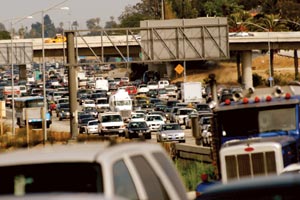Senior Reporter
CARB Truck and Bus Regulation Compliance Declined in 2015

The rate of compliance for heavy trucks with the California Air Resources Board’s truck and bus regulation has decreased to 70%-75% from 85% over the past two years, according to estimates in a new CARB enforcement report.
“This decrease in estimated compliance could be partly due to the continued phasing in of the regulatory requirements,” according to the agency’s report of 2015 enforcement activities. “To address this increase in noncompliance, enforcement division staff is taking several actions in 2016.”
Among those actions has been expanding use of the agency’s “Smart Audit” system, an approach for truck enforcement that shifts the workload from a complaint- and referral-driven process to a data-driven process that helps to focus enforcement efforts on noncompliant fleets.
The smart audit approach involves merging many data sources into one database.
“These sources include California and [the] 49 [other] state department of motor vehicles registration data, CARB compliance databases, citations and complaints, safety inspection databases, motor carrier permits, and any available data on high emitters,” the report said. “Vehicles are then grouped by fleet, and each fleet is evaluated using multiple audit indicators, given an audit score, and are prioritized for investigation.”
The report said that before 2015, diesel truck investigations were identified primarily through field inspections, tips and complaints, an inefficient process that led to identifying some cases as compliant after investigation.
This summer, the agency also plans to begin its enforcement of the tractor-trailer greenhouse-gas regulation, which requires equipping trucks and the trailers they pull with devices designed to increase aerodynamics and reduce drag while driving at highway speeds.
CARB, which has implemented the most rigorous state heavy-truck regulatory regime in the nation, said that in addition to enforcing rules related to traditional air quality and toxics emissions, the enforcement division is expanding its role in enforcing the agency’s greenhouse-gas rules, including landfill methane gas, refrigerant management, sulfur hexafluoride and the low-carbon fuel standard.
Last year, the division’s 178 employees conducted more than 32,000 inspections of vehicles, fuel tanks and equipment and wrote more than 4,400 citations ,resulting in more than $3.3 million in fines for noncompliance. About 64% of the diesel inspections conducted in 2015 focused on sources in or adjacent to disadvantaged communities.
The number of citations issued has increased substantially each year from 3,256 citations in 2014.
“The division closed more than 400 investigations and negotiated more than $10 million in assessed penalties,” the report said. CARB also collected nearly $21 million in three judgments from enforcement-related litigation.”
In addition, last year the enforcement division investigated 9,643 smoking commercial motor vehicle and 290 idling complaints, the report said.
CARB’s truck and bus regulation requires diesel trucks and buses that operate in California to be upgraded to reduce emissions requirements that the agency has been phasing in since 2012.
The ultimate goal of the regulation is to ensure that, by January 2023, nearly all trucks and buses have 2010 model year engines or equivalent.

